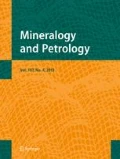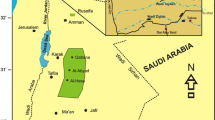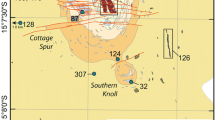Abstract
The composition of calcite and dolomite from several carbonatite complexes (including a large set of petrographically diverse samples from the Aley complex in Canada) was studied by electron-microprobe analysis and laser-ablation inductively-coupled-plasma mass-spectrometry to identify the extent of substitution of rare-earth and other trace elements in these minerals and the effects of different igneous and postmagmatic processes on their composition. Analysis of the newly acquired and published data shows that the contents of rare-earth elements (REE) and certain REE ratios in magmatic calcite and dolomite are controlled by crystal fractionation of fluorapatite, monazite and, possibly, other minerals. Enrichment in REE observed in some samples (up to ~2000 ppm in calcite) cannot be accounted for by coupled substitutions involving Na, P or As. At Aley, the REE abundances and chondrite-normalized (La/Yb)cn ratios in carbonates decrease with progressive fractionation. Sequestration of heavy REE from carbonatitic magma by calcic garnet may be responsible for a steeply sloping “exponential” pattern and lowered Ce/Ce* ratios of calcite from Magnet Cove (USA) and other localities. Alternatively, the low levels of Ce and Mn in these samples could result from preferential removal of these elements by Ce4+- and Mn3+-bearing minerals (such as cerianite and spinels) at increasing f(O2) in the magma. The distribution of large-ion lithophile elements (LILE = Sr, Ba and Pb) in rock-forming carbonates also shows trends indicative of crystal fractionation effects (e.g., concomitant depletion in Ba + Pb at Aley, or Sr + Ba at Kerimasi), although the phases responsible for these variations cannot be identified unambiguously at present. Overall, element ratios sensitive to the redox state of the magma and its complexing characteristics (Eu/Eu*, Ce/Ce* and Y/Ho) are least variable and in both primary calcite and dolomite, approach the average chondritic values. In consanguineous rocks, calcite invariably has higher REE and LILE levels than dolomite. Hydrothermal reworking of carbonatites does not produce a unique geochemical fingerprint, leading instead to a variety of evolutionary trends that range from light-REE and LILE enrichment (Turiy Mys, Russia) to heavy-REE enrichment and LILE depletion (Bear Lodge, USA). These differences clearly attest to variations in the chemistry of carbonatitic fluids and, consequently, their ability to mobilize specific trace elements from earlier-crystallized minerals. An important telltale indicator of hydrothermal reworking is deviation from the primary, chondrite-like REE ratios (in particular, Y/Ho and Eu/Eu*), accompanied by a variety of other compositional changes depending on the redox state of the fluid (e.g., depletion of carbonates in Mn owing to its oxidation and sequestration by secondary oxides). The effect of supergene processes was studied on a single sample from Bear Lodge, which shows extreme depletion in Mn and Ce (both due to oxidation), coupled with enrichment in Pb and U, possibly reflecting an increased availability of Pb2+ and (UO2)2+ species in the system. On the basis of these findings, several avenues for future research can be outlined: (1) structural mechanisms of REE uptake by carbonates; (2) partitioning of REE and LILE between cogenetic calcite and dolomite; (3) the effects of fluorapatite, phlogopite and pyrochlore fractionation on the LILE budget of magmatic carbonates; (4) the cause(s) of coupled Mn-Ce depletion in some primary calcite; and (5) relations between fluid chemistry and compositional changes in hydrothermal carbonates.





Similar content being viewed by others
References
Alexandratos VG, Elzinga EJ, Reeder RJ (2007) Arsenate uptake by calcite: macroscopic and spectroscopic characterization of adsorption and incorporation mechanisms. Geochim Cosmochim Acta 71:4172–4187
Anders E, Grevesse N (1989) Abundances of the elements: meteoritic and solar. Geochim Cosmochim Acta 53:197–214
Anovitz LM, Essene EJ (1987) Phase equilibria in the system CaCO3–MgCO3–FeCO3. J Petrol 28:389–414
Bau M (1996) Controls on the fractionation of isovalent trace elements in magmatic and aqueous systems: evidence from Y/Ho, Zr/Hf, and lanthanide tetrad effect. Contrib Mineral Petrol 123:323–333
Bau M, Koschinsky A (2009) Oxidative scavenging of cerium on hydrous Fe oxide: evidence from the distribution of rare earth elements and yttrium between Fe oxides and Mn oxides in hydrogenetic ferromanganese crusts. Geochem J 43:37–47
Bose PN (1884) Geology of the Lower Narbadá Valley between Nimáwar and Káwant. Mem Geol Soc India 21:1–72
Brice WR, Chang LLY (1973) Subsolidus phase relations in aragonite-type carbonates. III. The systems MgCO3-CaCO3-BaCO3, MgCO3-CaCO3-SrCO3, and MgCO3-SrCO3-BaCO3. Am Mineral 58:979–985
Brøgger WC (1921) Die Eruptivgesteine des Kristianiagebietes. IV. Das Fengebiet in Telemark, Norwegen. AW Brøggers Boktrykkeri A/S, Kristiania, 408 pp
Buckley HA, Woolley AR (1990) Carbonates of the magnesite-siderite series from four carbonatite complexes. Mineral Mag 54:413–418
Bühn B, Schneider G, Dulski P, Rankin AH (2003) Fluid-rock interaction during progressive migration of carbonatitic fluids, derived from small-scale trace element and Sr, Pb isotope distribution in hydrothermal fluorite. Geochim Cosmochim Acta 67:4577–4595
Chakhmouradian AR, Zaitsev AN (2012) Rare earth mineralization in igneous rocks: sources and processes. Elements 8:347–353
Chakhmouradian AR, Böhm CO, Demény A, Reguir EP, Hegner E, Creaser RA, Halden NM, Yang P (2009) “Kimberlite” from Wekusko Lake, Manitoba: actually a diamond-indicator-bearing dolomite carbonatite. Lithos 112S:347–357
Chakhmouradian AR, Reguir EP, Kamenetsky VS, Sharygin VV, Golovin AV (2013) Trace-element partitioning in perovskite: implications for the geochemistry of kimberlites and other mantle-derived undersaturated rocks. Chem Geol 353:112–131
Chakhmouradian AR, Reguir EP, Kressall RD, Crozier J, Pisiak L, Sidhu R, Yang P (2015a) Carbonatite-hosted niobium deposit at Aley, northern British Columbia (Canada): Mineralogy, geochemistry and petrogenesis. Ore Geol Rev 64:642–666
Chakhmouradian AR, Reguir EP, Zaitsev AN (2015) Calcite and dolomite in intrusive carbonatites. I. Textural variations. Mineral Petrol (this volume)
Chang LLY, Brice WR (1972) Subsolidus phase relations in aragonite-type carbonates: II. The systems CaCO3-SrCO3-PbCO3, and CaCO3-BaCO3-PbCO3. Am Mineral 57:165–168
Currie KL, Knutson J, Temby PA (1992) The Mud Tank carbonatite complex, central Australia – an example of metasomatism at mid-crustal levels. Contrib Mineral Petrol 109:326–339
Dawson JB, Hinton RW (2003) Trace-element content and partitioning in calcite, dolomite and apatite in carbonatite, Phalaborwa, South Africa. Mineral Mag 67:921–930
De Capitani C, Peters T (1981) The solvus in the system MnCO3-CaCO3. Contrib Mineral Petrol 76:394–400
Douville E, Charlou JL, Oelkers EH, Bienvenu P, Jove Colon CF, Donval JP, Fouquet Y, Prieur D, Appriou P (2002) The Rainbow vent fluids (36°14′N, MAR): the influence of ultramafic rocks and phase separation on trace metal content in Mid-Atlantic Ridge hydrothermal fluids. Chem Geol 184:37–48
Effenberger H, Mereiter K, Zemann J (1981) Crystal structure refinements of magnesite, calcite, rhodochrosite, siderite, smithonite, and dolomite, with discussion of some aspects of the stereochemistry of calcite type carbonates. Z Krist 156:233–243
Eickmann B, Bach W, Rosner M, Peckmann J (2009) Geochemical constraints on the modes of carbonate precipitation in peridotites from the Logatchev Hydrothermal Vent Field and Gakkel Ridge. Chem Geol 268:97–106
Faiziev AR, Gafurov FG (2010) Trace elements in calcite from the Darai Piez alkaline massif, Central Tajikistan. Geochem Int 48:1254–1258
Grice JD, Van Velthuizen J, Gault RA (2000a) Petersenite-(Ce), a new mineral from Mont Saint-Hilaire, and its structural relationship to other REE carbonates. Can Mineral 32:405–414
Grice JD, Gault RA, Roberts AC, Cooper MA (2000b) Adamsite-(Y), a new sodium-yttrium carbonate mineral species from Mont Saint-Hilaire, Quebec. Can Mineral 38:1457–1466
Högbom AE (1895) Über das Nephelinsyenitgebiet auf der Insel Alnö. Geol Fören Stockh Förh 17(101–158):214–258
Hornig-Kjarsgaard I (1998) Rare earth elements in sövitic carbonatites and their mineral phases. J Petrol 39:2105–2121
Ionov D, Harmer RE (2002) Trace element distribution in calcite-dolomite carbonatites from Spitskop: inferences for differentiation of carbonatite magmas and the origin of carbonates in mantle xenoliths. Earth Planet Sci Lett 198:495–510
Keller J, Zaitsev AN (2006) Calciocarbonatite dykes at Oldoinyo Lengai, Tanzania: the fate of natrocarbonatite. Can Mineral 44:857–876
Kelly SD, Rasbury ET, Chattopadhyay S, Krope AJ, Kemner KM (2006) Evidence of a stable uranyl site in ancient organic-rich calcite. Environ Sci Technol 40:2262–2268
Konev AA, Vorob’ev EI, Lazebnik KA (1996) Mineralogy of the Murun alkaline massif. Siberian Branch Russ Acad Sci, Novosibirsk, Russia, 221 pp (in Russian)
Le Maitre RW (ed) (2002) Igneous rocks: a classification and glossary of terms. Cambridge Univ Press, Cambridge, 236 pp
Markgraf SA, Reeder RJ (1985) High-temperature structure refinements of calcite and magnesite. Am Mineral 70:590–600
Marks MAW, Coulson IM, Schilling J, Jacob DE, Schmitt AK, Markl G (2008) The effect of titanite and other HFSE-rich mineral (Ti-bearing andradite, zircon, eudialyte) fractionation on the geochemical evolution of silicate melts. Chem Geol 257:153–172
Mitchell RH (2005) Carbonatites and carbonatites and carbonatites. Can Mineral 43:2049–2068
Moore M, Chakhmouradian AR, Mariano AN, Sidhu R (2015) Evolution of rare-earth mineralization in the Bear Lodge carbonatite, Wyoming: mineralogical and isotopic evidence. Ore Geol Rev 64:499–521
Ohta A, Kawabe I (2001) REE(III) adsorption onto Mn dioxide (δ-MnO2) and fe oxyhydroxide: Ce(III) oxidation by δ-MnO2. Geochim Cosmochim Acta 65:695–703
Ondruš P, Veselovský P, Gabašová A, Drábek M, Dobeš P, Malý K, Hloušek J, Sejkora J (2003) Ore-forming processes and mineral parageneses of the Jáchymov ore district. J Czech Geol Soc 48:157–192
Reeder RJ, Dollase WA (1989) Structural variation in the dolomite-ankerite solid-solution series: An X-ray, Miissbauer, and TEM study. Am Mineral 74:1159–1167
Reeder RJ, Schoonen MAA, Lanzirotti A (2006) metal speciation and its role in bioaccessibility and bioavailability. Rev Mineral Geochem 64:59–113
Reguir EP, Chakhmouradian AR, Halden NM, Yang P, Zaitsev AN (2008) Early magmatic and reaction-induced trends in magnetite from the carbonatites of Kerimasi, Tanzania. Can Mineral 46:879–900
Reguir EP, Chakhmouradian AR, Halden NM, Malkovets VG, Yang P (2009) Major- and trace-element compositional variation of phlogopite from kimberlites and carbonatites as a petrogenetic indicator. Lithos 112S:372–384
Schweer H, Seidel H (1981) Hochdrucksynthese von Carbonaten. VI. Natrium-Lanthanoid-Carbonate. Z Anorg Allg Chem 177:196–204
Shannon RD (1976) Revised effective ionic radii and systematic studies of interatomic distances in halides and chalcogenides. Acta Crystallogr A32:751–767
Sukheswala RN, Avasia RK (1971) Carbonatite-alkalic complex of Panwad-Kawant, Gujarat, and its bearing on the structural characteristics of the area. Bull Volcanol 35:564–578
Thomas JB, Bodnar RJ, Shimizu N, Shinha AK (2002) Determination of zircon/melt trace element partition coefficients from SIMS analysis of melt inclusions in zircon. Geochim Cosmochim Acta 66:2887–2901
van Achterbergh E, Ryan CG, Griffin WL (2001) GLITTER on-line interactive data reduction for the LA- ICPMS microprobe. Macquarie Research Ltd, Sydney
Villegas-Jiménez A, Mucci A, Paquette J (2009) Proton/calcium ion exchange behavior of calcite. Phys Chem Chem Phys 11:8895–8912
Wall F, Le Bas MJ, Srivastava RK (1993) Calcite and carbocernaite exsolution and cotectic textures in a Sr, REE-rich carbonatite dyke from Rajasthan, India. Mineral Mag 57:495–513
Wright CW (1915) Geology and ore deposits of Copper Mountain and Kasaan Peninsula, Alaska. US Geol Surv Prof Pap 87:11–110
Xu C, Campbell IH, Allen CM, Huang Z, Qi L, Zhang H, Zhang G (2007) Flat rare earth element patterns as an indicator of cumulate processes in the Lesser Qinling carbonatites, China. Lithos 95:267–278
Xu C, Campbell IH, Allen CM, Chen Y, Huang Z, Qi L, Zhang G, Yan Z (2008a) U-Pb zircon age, geochemical and isotopic characteristics of carbonatite and syenite complexes from the Shaxiongdong, China. Lithos 105:118–128
Xu C, Campbell IH, Kynicky J, Allen CM, Chen Y, Huang Z, Qi L (2008b) Comparison of the Daluxiang and Maoniuping carbonatitic REE deposits with Bayan Obo REE deposit, China. Lithos 106:12–24
Xu C, Kynicky J, Chakhmouradian AR, Campbell IH, Allen CM (2010) Trace-element modeling of the magmatic evolution of rare-earth-rich carbonatite from the Miaoya deposit, Central China. Lithos 118:145–155
Xu N, Chen M, Zhou K, Wang Y, Yin H, Chen Z (2014) Retention of phosphorus on calcite and dolomite: speciation and modeling. RSC Adv 4:35205–35214
Zaitsev AN (1996) A discussion of carbonatite evolution and nomenclature, and the generation of sodic and potassic fenites. Can Mineral 34:453–468
Zaitsev AN (2010) Nyerereite from calcite carbonatite at the Kerimasi volcano, northern Tanzania. Geol Ore Deposits 52:630–640
Zaitsev AN, Chakhmouradian AR, Siidra OI, Spratt J, Williams CT, Stanley CJ, Petrov SV, Britvin SN, Polyakova EA (2011) Fluorine-, yttrium- and lanthanide-rich cerianite from carbonatitic rocks of the Kerimasi volcano and surrounding explosion craters, Gregory Rift, northern Tanzania. Mineral Mag 75:2801–2810
Zaitsev AN, Williams CT, Jeffries TE, Strekopytov S, Moutte J, Ivashchenkova OV, Spratt J, Petrov SV, Wall F, Seltmann R, Borozdin AP (2014) Rare earth elements in phoscorites and carbonatites of the Devonian Kola Alkaline Province, Russia: examples from Kovdor, Khibina, Vuoriyarvi and Turiy Mys complexes. Ore Geol Rev 61:204–225
Zhong S, Mucci A (1995) Partitioning of rare earth elements (REEs) between calcite and seawater solutions at 25 °C and 1 atm, and high dissolved REE concentrations. Geochim Cosmochim Acta 59:443–453
Acknowledgments
This work was supported by the Natural Sciences and Engineering Research Council of Canada (NSERC) and Manitoba Geological Survey. The instrumentation used for data collection was supported by the NSERC and Canada Foundation for Innovation. Taseko Mines Ltd. and Jeremy Crozier are gratefully acknowledged for providing us with access to the Aley property and drill core. Meghan Moore and Alexey Rukhlov are thanked for the Bear Lodge and Upper Fir samples, respectively. The material from Kerimasi, Prairie Lake and Magnet Cove was provided by the Natural History Museum (London, UK). The present manuscript has benefited from constructive reviews provided by two anonymous referees.
Author information
Authors and Affiliations
Corresponding author
Additional information
Editorial handling: L. G. Gwalani
Rights and permissions
About this article
Cite this article
Chakhmouradian, A.R., Reguir, E.P., Couëslan, C. et al. Calcite and dolomite in intrusive carbonatites. II. Trace-element variations. Miner Petrol 110, 361–377 (2016). https://doi.org/10.1007/s00710-015-0392-4
Received:
Accepted:
Published:
Issue Date:
DOI: https://doi.org/10.1007/s00710-015-0392-4




